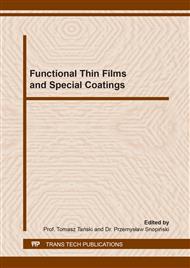[1]
N. Pinna, M. Knez, Atomic Layer Deposition of Nanostructured Materials, Wiley-VCH, Weinheim (2012).
Google Scholar
[2]
A.C. Jones, M.L. Hitchman, Chemical Vapour Deposition 'Precursors, Processes and Applications, The Royal Society of Chemistry, United Kingdom (2009).
Google Scholar
[3]
H.S. Nalwa, Handbook of thin film materials Vol. 1, Deposition and processing of thin films, Academic Press, San Diego (2002).
Google Scholar
[4]
L.A. Dobrzański, A. Drygała, K. Gołombek, P. Panek, E. Bielańska, P. Zięba, Laser surface treatment of multicrystalline silicon for enhancing optical properties, Journal of Materials Processing Technology 201/1 (2008) 291-296.
DOI: 10.1016/j.jmatprotec.2007.11.278
Google Scholar
[5]
L.A. Dobrzański, M. Szindler, Sol-gel and ALD antireflection coatings for silicon solar cells, Electronics 53/8 (2012) 125-127.
Google Scholar
[6]
J. Weszka, M.M. Szindler, M. Chwastek-Ogierman, M. Bruma, P. Jarka, B. Tomiczek, Surface morphology of thin films polyoxadiazoles, Journal of Achievements in Materials and Manufacturing Engineering 49/2 (2011) 224-232.
Google Scholar
[7]
L.A. Dobrzański, M. Szindler, A. Drygała, M.M. Szindler, Silicon solar cells with Al2O3 antireflection coating, Central European Journal of Physics 12/9 (2014) 666–670.
DOI: 10.2478/s11534-014-0500-9
Google Scholar
[8]
H.M. Ali, H.A. Mohamed, S.H. Mohamed, Enhancement of the optical and electrical properties of ITO thin films deposited by electron beam evaporation technique, The European Physical Journal Applied Physics 31 (2005)87-93.
DOI: 10.1051/epjap:2005044
Google Scholar
[9]
L. Wei, C. Shuying, Photoelectric properties of ITO thin films deposited by DC magnetron sputtering, Journal of Semiconductors 32/1 (2011) 013002.
DOI: 10.1088/1674-4926/32/1/013002
Google Scholar
[10]
M. Oshima, K. Yoshino, Characteristic of low resistivity fluorine-doped SnO2 thin films grown by spray pyrolysis, Japanese Journal of Applied Physics 50/5S2 (2011) 05FB15.
DOI: 10.1143/jjap.50.05fb15
Google Scholar
[11]
K. Ellmer, A. Klein, B. Rech, Transparent Conductive Zinc Oxide, Springer, Berlin (2008).
Google Scholar
[12]
T. Tynell, M. Karppinen, Atomic layer deposition of ZnO, A review, Semiconductor Science and Technology 29 (2014) 043001.
DOI: 10.1088/0268-1242/29/4/043001
Google Scholar
[13]
P.M. Martin (ed.), Handbook of deposition technologies for films and coatings - science, applications and technology, Elsevier Inc., USA (2010).
Google Scholar
[14]
F. Li, L. Li, X. Liaoa, Y. Wanga, Precise pore size tuning and surface modifications of polymeric membranes using the atomic layer deposition technique, Journal of Membrane Science 385-386 (2011) 1-9.
DOI: 10.1016/j.memsci.2011.06.042
Google Scholar
[15]
B. Vermang, H. Goverde, A. Uruena, A. Lorenz, E. Cornagliotti, A. Rothschild, J. John, J. Poortmans, R. Mertens, Blistering in ALD Al2O3 passivation layers as rear contacting for local Al BSF Si solar cells, Solar Energy Materials & Solar Cells 101 (2012) 204–209.
DOI: 10.1016/j.solmat.2012.01.032
Google Scholar
[16]
R. Escudero and R. Escamilla, Ferromagnetic behavior of high-purity ZnO nanoparticles , Solid State Communications 151/2 (2011) 97–101.
DOI: 10.1016/j.ssc.2010.11.019
Google Scholar
[17]
J. Laube, D. Nübling, H. Beh, S. Gutsch, D. Hiller and M. Zacharias, Resistivity of atomic layer deposition grown ZnO: The influence of deposition temperature and post-annealing, Thin Solid Films 603 (2016) 377-381.
DOI: 10.1016/j.tsf.2016.02.060
Google Scholar
[18]
M.S. Farhan, E. Zalnezhad, A.R. Bushroa, A.A. D. Sarhan, Electrical and Optical Properties of Indium-tin Oxide (ITO) Films by Ion-Assisted Deposition (IAD) at Room Temperature, International Journal of Precision Engineering and Manufacturing 2, 14/8 (2013) 1465-1469.
DOI: 10.1007/s12541-013-0197-5
Google Scholar
[19]
M.M. Ristova, A. Gligorova, I. Nasov, D. Gracin, M. Milun, H. Kostadinova-Boskova, R. Popeski-Dimovski, TiO2 Coating for SnO2: F Films Produced by Filtered Cathodic Arc Evaporation for Improved Resistance to H+ Radical Exposure, Journal of Electronic Materials, 41/11 (2012) 3087-3094.
DOI: 10.1007/s11664-012-2221-4
Google Scholar
[20]
Z. Baji, Z. Lábadi, G. Molnár, B. Pécz, K. Vad, Z.E. Horváth, P.J. Szabó, T. Nagata, J. Volk, Highly conductive epitaxial ZnO layers deposited by atomic layer deposition, Thin Solid Films 562 (2014) 485-489.
DOI: 10.1016/j.tsf.2014.04.047
Google Scholar
[21]
A. Illiberi, F. Roozeboom, P. Poodt, Spatial atomic layer deposition of zinc oxide thin films, Applied Materials & Interfaces 4/1 (2012) 268–272.
DOI: 10.1021/am2013097
Google Scholar
[22]
E. Guziewicz, M. Godlewski, T.A. Krajewski, Ł. Wachnicki, G. Łuka, W. Paszkowicz, J.Z. Domagała, E. Przeździecka, E. Łusakowska, ZnO by ALD — Advantages of the Material Grown at Low Temperature, Acta Physica Polonica A, 116 (2009) 814-817.
DOI: 10.12693/aphyspola.116.814
Google Scholar
[23]
Y.S. Min, C.J. An, S.K. Kim, J. Song, C.S. Hwang, Growth and Characterization of Conducting ZnO Thin Films by Atomic Layer Deposition, Bulletin of the Korean Chemical Society, 31 (2010) 2503-2508.
DOI: 10.5012/bkcs.2010.31.9.2503
Google Scholar
[24]
A. Ismail, M.J. Abdullah, The structural and optical properties of ZnO thin films prepared at different RF sputtering power, Journal of King Saud University – Science, 25/3 (2013) 209–215.
DOI: 10.1016/j.jksus.2012.12.004
Google Scholar
[25]
E. Przeździecka, Ł. Wachnicki, W. Paszkowicz, E. Łusakowska, T. Krajewski, G. Łuka, E. Guziewicz, M. Godlewski, Photoluminescence, electrical and structural properties of ZnO films, grown by ALD at low temperature, Semicond. Sci. Technol. 24 (2009) 105014.
DOI: 10.1088/0268-1242/24/10/105014
Google Scholar
[26]
V.V. Strelchuk, K.A. Avramenko, A.S. Romaniuk, L.V. Zavyalova, G.S. Svechnikov, V.S. Khomchenko, N.M. Roshchina, V.M. Tkach, Structural and optical properties of ZnO films produced by a nonvacuum chemical technique, Semiconductors, 48/9 (2014) 1145-1150.
DOI: 10.1134/s106378261409019x
Google Scholar


